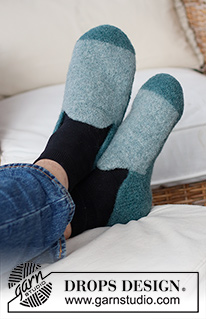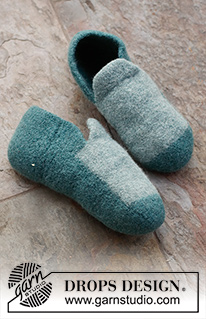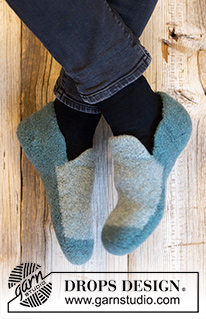Comments / Questions (5)
![]() Selma wrote:
Selma wrote:
Hej igen, för att förtydliga min fråga ovan, vilken sida är rät vid rätstickning? Det står i beskrivningen sör häl att man ska börja på rätsida men båda sidor ser likadana ut vid rätstickning..
10.01.2023 - 15:35DROPS Design answered:
Hej Selma, du bestemmer selv hvilken side du vælger som retside, da begge sider ser ligedan ud :)
12.01.2023 - 13:57
![]() Selma wrote:
Selma wrote:
Det står rätstickning dvs rät-rät men sen står det på beskrivningen för häl att börja från rätsida osv.. jag börjat om för att sticka rät-avig men förstår inte vilket det ska vara?
05.01.2023 - 22:53DROPS Design answered:
Hej Selma, vi forstår ikke rigtig dit spørgsmål, men se måleskitsen nederst i mønsteret, her kan du se hvilket stykke som er hæl og som skal strikkes rätstickning :)
10.01.2023 - 10:52
![]() Marina wrote:
Marina wrote:
Non sono sicura di aver compreso bene l'istruzione per il tallone. Sono arrivata alla fine del lavoro con i ferri accorciati (11 punti giro a ogni lato). Ora devo continuare a lavorare a ferri accorciati, lavorando ogni ferro una maglia in più, fino a quando non li lavoro tutti (quindi altri 22 ferri), giusto?
29.11.2022 - 18:14DROPS Design answered:
Buongiorno Marina, il procedimento è corretto. Buon lavoro!
03.12.2022 - 16:26
![]() MARTIN wrote:
MARTIN wrote:
Bonjour, est-il possible d'avoir le patron avec les mesures ? Merci.
11.11.2022 - 11:44DROPS Design answered:
Bonjour Mme Martin, nous n'avons pas ce type de mesures pour ces chaussons, vérifiez bien votre tension et suivez attentivement les explications, vous aurez alors la bonne forme/les bonnes mesures. Bon tricot!
14.11.2022 - 08:47
![]() Jonna wrote:
Jonna wrote:
Har I ikke Eskimo længere Venligst jonna
28.09.2022 - 18:28DROPS Design answered:
Hej Jonna, Jo det er den som hedder DROPS Snow :)
29.09.2022 - 09:21
Good Morning Slippers#goodmorningslippers |
|||||||
 |
 |
||||||
Felted slippers for men in DROPS Alaska. Sizes 35-46.
DROPS 224-32 |
|||||||
|
------------------------------------------------------- EXPLANATIONS FOR THE PATTERN: ------------------------------------------------------- RIDGE/GARTER STITCH (worked back and forth): Knit all rows. 1 ridge = knit 2 rows. DIAGRAM: See diagram A.1 - the diagram shows how to fold the slipper when assembling. ------------------------------------------------------- START THE PIECE HERE: ------------------------------------------------------- SLIPPERS – SHORT OVERVIEW OF THE PIECE: The slipper is worked back and forth in one piece. Start at the back edge, work the heel, the sole, the toe and finish off by working the top. When finished it is sewn together and felted in the washing machine. SLIPPER: BACK EDGE: Cast on 23-25-26-28 stitches with needle size 5.5 mm and colour north sea. Work 9 RIDGES – read description above. REMEMBER THE KNITTING TENSION! HEEL: Work short rows for the heel; all rows are knitted (= garter stitch). Start from the right side as follows: Knit until there is 1 stitch left on the row, turn and knit until there is 1 stitch left. * Turn and knit until there is 1 stitch left before the previous turn, turn and knit until there is 1 stitch left before the previous turn *, work from *-* until you have 5-5-6-6 stitches in the middle of the needle (turned 9-10-10-11 times each side). Now work 1 more stitch after each time you turn until you can work all the stitches again = 23-25-26-28 stitches. Insert a marker in the middle of the row to measure the foot-length from. SOLE: Work garter stitch and decrease 4 stitches evenly on the first row (19-21-22-24 stitches), then continue working garter stitch until the piece measures 18½-20-24-27 cm from the marker. TOE: Work short rows to shape the toe, all rows are knitted (= garter stitch). Start from the right side as follows: Knit until there is 1 stitch left on the row, turn and knit until there is 1 stitch left. * Turn and knit until there is 1 stitch left before the previous turn, turn and knit until there is 1 stitch left before the previous turn *, work from *-* until you have 5-5-6-6 stitches in the middle of the needle (turned 7-8-8-9 times each side). Now work 1 more stitch after each time you turn until you can work all the stitches again = 19-21-22-24 stitches. Insert a marker in the middle of the row to measure from. TOP: Change to colour sage green. Work stocking stitch for 9-10-12-13 cm. On the next row from the right side increase 4 stitches evenly spaced (make 1 yarn over which is purled twisted on the next row) = 23-25-26-28 stitches. Continue with stocking stitch until you have worked a total of 13½-15-19-22 cm and the next row is from the right side. Now work the first 5 stitches on the row; the other stitches are placed on a thread. Change to colour north sea and work garter stitch, increasing 1 stitch inside the last stitch on each row from the right side 5 times (the garter stitch should measure 5 cm (do not stretch the piece). Cast off on the next row from the right side. Place the last 5 stitches from the thread back on the needle (the middle 13-15-16-18 stitches remain on the thread). Change to colour north sea and work garter stitch, increasing 1 stitch inside the first stitch on each row from the right side 5 times (the garter stitch should measure 5 cm (do not stretch the piece). Cast off on the next row from the wrong side. Place the last 13-15-16-18 stitches back on the needle. Use colour sage green and work 6 ridges (the first row is from the right side) AT THE SAME TIME as you decrease as follows on every 4th row: Knit together the outside 2 stitches on each side. Decrease a total of 3 times = 7-9-10-12 stitches. Cast off on the next row from the right side. ASSEMBLY: Sew together from the wrong side. Fold the piece at the toe so that the top lies over the sole. See diagram A.1 that shows how the slipper is folded. Start by sewing the 9 ridges on the back edge together to the 10 cast-off stitches on the outside of the top. Then sew the top and sole together, edge to edge as far as the toe. Repeat on the other side. Work the other slipper in the same way. FELTING: Place the slippers in the washing machine using a detergent without enzymes or optical bleaches. Wash at 40 degrees with normal centrifuge and without pre-wash. After washing shape the slippers while still wet. Later wash as a normal wool garment. AFTER FELTING: If the piece is not felted enough and is too big: Wash the piece one more time in the washing machine while it is still wet add a terry towel that measures approx. 50 x 70 cm - NOTE: Do not use a short program. If the piece has been felted too much and is too small: While the piece is still wet stretch it to the correct measurements, if the piece is dry, make sure to soak it first. Remember: All subsequent washes are as a normal wool garment. |
|||||||
Diagram explanations |
|||||||
|
|||||||

|
|||||||
Have you finished this pattern?Tag your pictures with #dropspattern #goodmorningslippers or submit them to the #dropsfan gallery. Do you need help with this pattern?You'll find 15 tutorial videos, a Comments/Questions area and more by visiting the pattern on garnstudio.com. © 1982-2025 DROPS Design A/S. We reserve all rights. This document, including all its sub-sections, has copyrights. Read more about what you can do with our patterns at the bottom of each pattern on our site. |
|||||||

























































Post a comment to pattern DROPS 224-32
We would love to hear what you have to say about this pattern!
If you want to leave a question, please make sure you select the correct category in the form below, to speed up the answering process. Required fields are marked *.